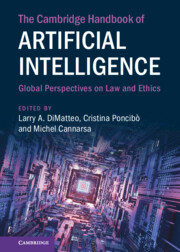
-
Select format
-
- Publisher:
- Cambridge University Press
- Publication date:
- July 2022
- August 2022
- ISBN:
- 9781009072168
- 9781316512807
- Dimensions:
- (254 x 178 mm)
- Weight & Pages:
- 1.03kg, 400 Pages
- Dimensions:
- Weight & Pages:
- Series:
- Cambridge Law Handbooks
- Subjects:
- Intellectual Property, Law: General Interest, Law, Law and technology, science, communication
- Collection:
- Cambridge Law Handbooks
You may already have access via personal or institutional login- Series:
- Cambridge Law Handbooks
- Subjects:
- Intellectual Property, Law: General Interest, Law, Law and technology, science, communication
- Collection:
- Cambridge Law Handbooks
Book description
The technology and application of artificial intelligence (AI) throughout society continues to grow at unprecedented rates, which raises numerous legal questions that to date have been largely unexamined. Although AI now plays a role in almost all areas of society, the need for a better understanding of its impact, from legal and ethical perspectives, is pressing, and regulatory proposals are urgently needed. This book responds to these needs, identifying the issues raised by AI and providing practical recommendations for regulatory, technical, and theoretical frameworks aimed at making AI compatible with existing legal rules, principles, and democratic values. An international roster of authors including professors of specialized areas of law, technologists, and practitioners bring their expertise to the interdisciplinary nature of AI.
Reviews
‘What should lawyers make of the rapid insinuation of AI into our everyday dealings and decisions, including its reshaping of legal practices? In this impressive Handbook, a team of leading scholars and practitioners showcase the breadth, detail, and depth of private law’s engagement with AI. It is a compelling read.’
Roger Brownsword - King’s College London and Bournemouth University
‘The Handbook provides a tour de force for the impact of AI from technical, legal-regulatory, societal, democratic and ethical perspectives, taking into account current developments and trends in the field, as much as that which we should reasonably expect in the future. Scholars and the public are warmly invited to take this tour.’
Ugo Pagallo - University of Turin
‘The editors are to be congratulated on this excellent work. … this is an outstanding book that provides much food for thought.’
Tania Sourdin Source: Prometheus
Contents
Metrics
Altmetric attention score
Full text views
Full text views help Loading metrics...
Loading metrics...
* Views captured on Cambridge Core between #date#. This data will be updated every 24 hours.
Usage data cannot currently be displayed.
Accessibility standard: Unknown
Why this information is here
This section outlines the accessibility features of this content - including support for screen readers, full keyboard navigation and high-contrast display options. This may not be relevant for you.
Accessibility Information
Accessibility compliance for the PDF of this book is currently unknown and may be updated in the future.


